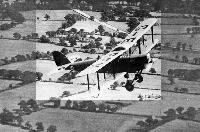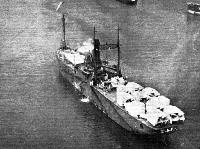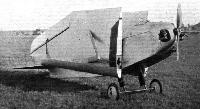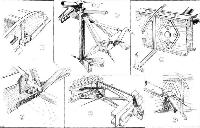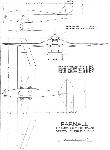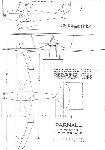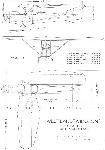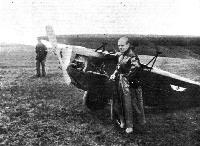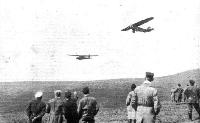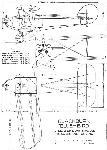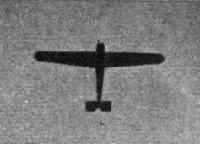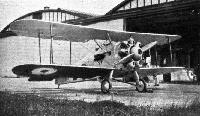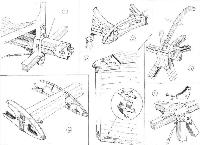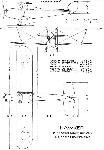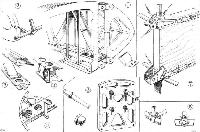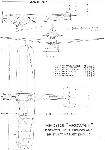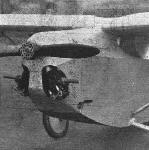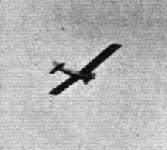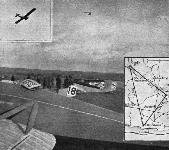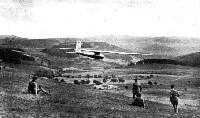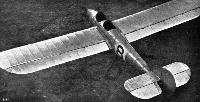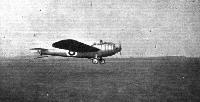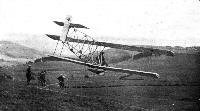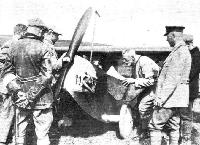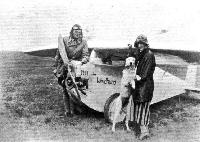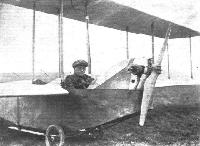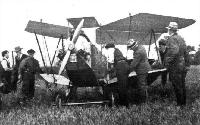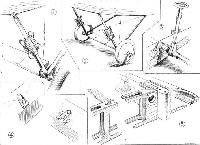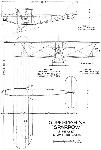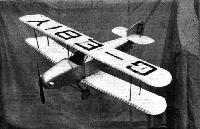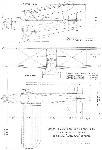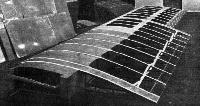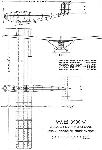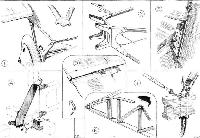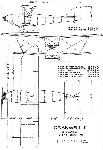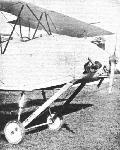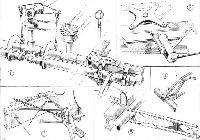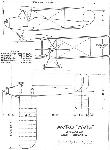Фотографии
-
Регистрационный номер: G-EBFN На de Havilland DH.50 ставили самые разные моторы, включая ADC Nimbus, Bristol Jupiter IV, Jupiter VI, Jupiter XI и Pratt & Whitney Wasp С. Чехи оснащали эти самолеты моторами Walter W-4.
The D.H.50 biplane, 230 h.p. Siddeley "Puma": It •was on a similar machine to this, G-EBFP, that Alan Cobham made his splendid flight to Tangier and back.Самолёты на фотографии: De Havilland D.H.50 - Великобритания - 1923
-
MOROCCO BOUND: Our photograph shows the Spanish aircraft carrier "Dedalo," with a number of Supermarine flying boats stowed on deck, steaming down Southampton Water en route for Morocco. No doubt upon arrival the Spanish forces will greet them with "the 'moor' the merrier."
Самолёты на фотографии: Supermarine Sea Eagle - Великобритания - 1923
-
The Parnall "Pixie" two-seater light 'plane has a forced landing. On a recent flight the machine came down at Henbury owing to plug trouble. It had its wings folded, was pushed through four gateways to a larger field, from which it took off quite easily, and returned safely to the Filton Aerodrome.
Самолёты на фотографии: Parnall Pixie - Великобритания - 1923
-
The Parnall "Pixie III," with wings folded for transport. Note the neat cowling around the Bristol "Cherub" engine. The cantilever undercarriage should be observed.
Самолёты на фотографии: Parnall Pixie - Великобритания - 1923
-
Side elevation of the Parnall two-seater light monoplane.
Самолёты на фотографии: Parnall Pixie - Великобритания - 1923
-
SOME CONSTRUCTIONAL DETAILS OF THE PARNALL TWO-SEATER LIGHT MONOPLANE: 1. A wing root, showing trunnion for attachment to fuselage. 2. The wing in place, showing attachment. 3. Lay shaft and cranks of the elevator. The tail plane tube has been omitted for the sake of clearness, as has also the tail skid, which is made from cane. 4. Details of the differential aileron control. The two cables run to the controls in the cockpit. 5. Shows the spar construction. 6. The lift tubes are attached not direct to the spar, but to the tubular compression strut of the drag bracing, so that the angularity of the lift strut does not produce twist in the spar.
Самолёты на фотографии: Parnall Pixie - Великобритания - 1923
-
Parnall 2-seater Light Monoplane Bristol Cherub Engine
Самолёты на фотографии: Parnall Pixie - Великобритания - 1923
-
Parnall 2-seater Light Biplane
Самолёты на фотографии: Parnall Pixie - Великобритания - 1923
-
Wind-tunnel model of the Westland "Widgeon" parasol monoplane. No engine is shown, but will be fitted in the nose.
Самолёты на фотографии: Westland Widgeon - Великобритания - 1924
-
Westland Widgeon 2-seater Light Monoplane
Самолёты на фотографии: Westland Widgeon - Великобритания - 1924
-
The Udet "Kolibri," with 750 c.c. Douglas engine, has flown for 4 hours 39 minutes in the Rhon. Our photograph shows Herr Udet and his machine.
Самолёты на фотографии: Udet U-7 Kolibri - Германия - 1924
-
The Udet "Kolibri" and the Baumer "Roter Vogel" in the air together in the Rhon.
Самолёты на фотографии: Baumer B.I Roter Vogel - Германия - 1923Udet U-7 Kolibri - Германия - 1924
-
Blackburn "Blue-Bird" 2-seater Light Biplane Blackburne Engine
Самолёты на фотографии: Blackburn Bluebird / L.1 - Великобритания - 1924
-
ONE OF TWO PRIZE-WINNERS AT LYMPNE: Flight-Lieut. Longton, flying the "Wren" No. 4.
Самолёты на фотографии: English Electric Wren - Великобритания - 1923
-
The Sopwith-Hawker "Woodcock," with Bristol "Jupiter" Engine: Three-quarter front view.
Самолёты на фотографии: Hawker Woodcock - Великобритания - 1923
-
Регистрационный номер: J6988 THE SOPWITH-HAWKER "WOODCOCK": Three-quarter rear view.
Самолёты на фотографии: Hawker Woodcock - Великобритания - 1923
-
SOME CONSTRUCTIONAL DETAILS OF THE HAWKER LIGHT TWO-SEATER BIPLANE: 1 shows a typical fitting attaching the lower front spar to the lower longeron. In 2 is shown the manner in which the projecting spar roots are strengthened and streamlined. Note the hinge on the rear spar for folding the wing. The fuselage construction, using X-section longerons and struts connected by three-ply gussets, is shown in 3 while details of the wing construction are shown in 4. Examples of bent plate work in the region of the stern post are illustrated in 5, and 6 shows the flat plate fitting at the point of attachment of the centre-section struts to the fuselage longeron.
Самолёты на фотографии: Hawker Cygnet - Великобритания - 1924
-
Hawker 2-seater Light Biplane A.B.C. "Scorpion" Engine
Самолёты на фотографии: Hawker Cygnet - Великобритания - 1924
-
REMINISCENCES OF LAST YEAR'S LYMPNE COMPETITIONS: The photograph shows Mr. Broad flying the de Havilland 53, while the inset is a view from underneath of the "Wren" on which Longton tied with James for the consumption prize.
Самолёты на фотографии: De Havilland Humming Bird / D.H.53 - Великобритания - 1923
-
The Vagabond was built by A. V. Roe at Hamble and it was prooably in the state pictured at left that it was delivered to the Vickers Weybridge factory.
Самолёты на фотографии: Vickers Vagabond - Великобритания - 1924
-
THE VICKERS "VAGABOND": Three-quarter rear view of the machine in skeleton.
Самолёты на фотографии: Vickers Vagabond - Великобритания - 1924
-
SOME VICKERS CONSTRUCTIONAL DETAILS: 1. The aileron crank inside me wing, giving a differential movement to the ailerons. 2. Details of the fuselage fittings. These are similar to those used on the "Viget" 3. The trailing edge is folded with the wings, and is secured by hinges of the form shown. 4. An aileron hinge.
Самолёты на фотографии: Vickers Vagabond - Великобритания - 1924
-
Vickers "Vagabond" 2-seater Light Biplane
Самолёты на фотографии: Vickers Vagabond - Великобритания - 1924
-
Регистрационный номер: G-EBJK [2] THE BRISTOL "BROWNIE," BRISTOL "CHERUB" ENGINE: Front view.
Самолёты на фотографии: Bristol Brownie / Type 91 - Великобритания - 1924
-
Регистрационный номер: G-EBJK [2] THE BRISTOL "BROWNIE" LIGHT MONOPLANE, BRISTOL "CHERUB" ENGINE: Three-quarter front view.
Самолёты на фотографии: Bristol Brownie / Type 91 - Великобритания - 1924
-
SOME BRISTOL "BROWNIE" CONSTRUCTIONAL DETAILS: Some of our sketches show features common to all three Bristol machines, but those relating to the wing structure show the all-metal construction. 1, the root of the port wing. Note the very original spar web, consisting of a circular steel tube bent zig-zag fashion and flattened out at the points of attachment to the spar flanges. 2, details of the attachment of the leading edge. 3, 4 and 5, details of the spar construction. Towards the wing tip, where the spar depth becomes smaller, the zig-zag web is not continued, and the construction is of the form shown. 6 illustrates the mounting of the "Cherub" engine on four tubular cantilever pillars without bracing. These pillars are permanently bolted to the engine, and are attached to the engine bulkhead by unions. 7 shows the attachment of the wing to the fuselage. A wood bulkhead is built-in at this point, although the fuselage is of steel tube construction, and the upper spar flange attachment has provision for setting dihedral and incidence by the micrometer adjustment shown. 8 shows a typical fuselage joint.
Самолёты на фотографии: Bristol Brownie / Type 91 - Великобритания - 1924
-
Bristol "Brownie" 2-seater Light Monoplane Bristol "Cherub" Engine
Самолёты на фотографии: Bristol Brownie / Type 91 - Великобритания - 1924
-
Регистрационный номер: F-ESAR The Farman F.121 "Jabiru," four Hispano-Suiza engines, which won this year's Grand Prix for commercial aeroplanes.
Самолёты на фотографии: Farman F.120 / F.3X / F.4X Jabiru - Франция - 1923
-
FROM THE RHON MEETING: Two of Arthur Martens' machines, the "Moritz" and the "Strolch." Both are very reminiscent of the famous "Vampyr."
Самолёты на фотографии: Hannover H.1 Vampyr / H.2 Greif / Strolch - Германия - 1921
-
A U.S. Navy Experimental 'Plane: The Longren biplane, 60 h.p. three-cylinder air-cooled Wright engine, about to start on a trial flight.
Самолёты на фотографии: Longren AK - США - 1921
-
THE "A.N.E.C. II" LIGHT MONOPLANE: This three-quarter front view gives a good idea of the lines of the machine, which are exceptionally "clean." Note the inverted position of the 1,100-c.c. Anzani engine, and the manner in which this mounting improves the view. Gravity feed from the tank in the deck fairing is also facilitated.
Самолёты на фотографии: ANEC I / II - Великобритания - 1923
-
The Anzani engine in the "A.N.E.C. II" monoplane. Note the inverted position.
Самолёты на фотографии: ANEC I / II - Великобритания - 1923
-
ONE OF TWO PRIZE-WINNERS AT LYMPNE: James's A.N.E.C. monoplane (No. 17), on which he tied with Flight-Lieut. Longton, flying the "Wren" No. 4, for the Duke of Sutherland's and the "Daily Mail" prizes.
Самолёты на фотографии: ANEC I / II - Великобритания - 1923
-
SOME CONSTRUCTIONAL DETAILS OF THE A.N.E.C. MONOPLANE: 1, A general view of one side of the very simple undercarriage. The axle is a bent tube, so fixed in the sides of the fuselage that it cannot turn. The only springing is that provided by the flexibility of the axle, and by the pneumatic tyres. The view in Fig. 2 gives an idea of the general arrangement of the chassis. 3 shows the root of the port wing with cut-out portion for front cockpit. The wing spars are hinged to the top fairing of the fuselage. 4, Details of the lift-strut attachment to the wing spar. The lower end of the strut is secured to the fitting shown in 1. The tail, Fig. 5, is attached to the stern of the fuselage as shown, the fin being in two sections of which one is integral with the fuselage structure. The elevator carries out the lines of the fuselage, and is hinged at its upper edge, being operated by a push-and-pull rod from the body.
Самолёты на фотографии: ANEC I / II - Великобритания - 1923
-
A.N.E.C. 2-seater Light Monoplane
Самолёты на фотографии: ANEC I / II - Великобритания - 1923
-
Регистрационный номер: J7322 REMINISCENCES OF LAST YEAR'S LYMPNE COMPETITIONS: The picture shows Hinkler flying the Avro monoplane on which he covered a distance of 1,000 miles during the week, while inset is the A.N.E.C. monoplane on which James tied with Longton.
Самолёты на фотографии: Avro Type 560 - Великобритания - 1923
-
FROM THE RHON MEETING: The Darmstadt "Konsul" making a landing on a predetermined spot. It was on this machine that Botsch flew 19 kilometres last year. Note the extremely high aspect ratio.
Самолёты на фотографии: Darmstadt D-09 Konsul / D-12 Romryke Berge - Германия - 1923
-
The "Roemryke Berge" of the Lower Rhenish Aero Society starting for a flight. This photograph shows admirably the nature of the country in the Rhon.
552Самолёты на фотографии: Darmstadt D-09 Konsul / D-12 Romryke Berge - Германия - 1923
-
Регистрационный номер: G-EBJD AN ARCTIC AVRO: These photographs show the Avro-"Lynx" of the Oxford University Arctic Expedition, which, under Mr. George Binney, has been making good use of the seaplane. The machine and its Armstrong-Siddeley "Lynx" carries a very heavy load, but nevertheless on test got off the water easily. The general views, 1 and 5, give a good idea of the lines of the machine. In 2 it is seen taxying, while 3 shows the special engine mounting designed for the "Lynx." A cowl is, of course, fitted for actual flying in the Arctic. 4 shows the Norwegian sled carried under the deck fairing. The front view, 6, shows the long floats, and the two extra petrol service tanks under the top plane. A third tank is built into the top centre-section.
Самолёты на фотографии: Avro Avro 504N - Великобритания - 1920
-
THE SHORT "SATELLITE," BRISTOL "CHERUB" ENGINE: Three-quarter front view from above.
Самолёты на фотографии: Short Satellite / S.4 - Великобритания - 1924
-
THE SHORT "SATELLITE": Three-quarter rear view, from above.
Самолёты на фотографии: Short Satellite / S.4 - Великобритания - 1924
-
The Short "Satellite" starting on a flight.
Самолёты на фотографии: Short Satellite / S.4 - Великобритания - 1924
-
SOME SHORT CONSTRUCTIONAL DETAILS: 1. The very neat engine mounting for the Bristol "Cherub." This mounting should be particularly good in respect of torsional stresses. 2. The oleo undercarriage. 3. Attachment of tail skid fixed end to fuselage. 4. The renewable shoe on the free end of the tail skid. 5. An aileron hinge. 6. The port wing root showing inspection doors giving access to wing attachments. The ailerons are operated by torque tubes.
Самолёты на фотографии: Short Satellite / S.4 - Великобритания - 1924
-
A SCHOOL MACHINE AT RHON: A pupil starting on his first flight in a Martens School biplane, the simple and robust construction.
Самолёты на фотографии: Martens S - Германия - 1924
-
Light Planes at Rhon: The Baumer Aero "Roter Vogel" (No. 74) is fitted with a Douglas engine mounted in a somewhat unusual position. The machine is of usual glider type, and the placing of the engine, with long shaft to tractor airscrew, has evidently been chosen to obtain correct trim.
Самолёты на фотографии: Baumer B.I Roter Vogel - Германия - 1923
-
In the Rhon: Prince Heinrich inspects the Messerschmitt light 'plane which is fitted with a Douglas engine.
Самолёты на фотографии: Messerschmitt S15 / S16 / M.17 - Германия - 1923
-
The Martens family: This photograph shows Herr and Frau Arthur Martens standing by the Martens "Windhund" light 'plane. The machine has a Douglas engine.
Самолёты на фотографии: Martens Windhund - Германия - 1924
-
No.55, the Blume-Hentzen "Habicht," starting on a flight in the Rhon. This machine is fitted with a 750 c.c. Siemens engine.
Самолёты на фотографии: Blume-Hentzen Habicht - Германия - 1924
-
A Weltensegler light biplane: The pilot is Herr Wolff Hirth, brother of the famous German pilot Hellmuth Hirth.
Самолёты на фотографии: Weltensegler biplane - Германия - 1924
-
Not a Helicopter, but the Supermarine "Sparrow" light biplane, with wings partly folded. Note the three-cylinder Blackburne engine. The man on the left, who appears to be threatening Mr. Mitchell with a club, is not, we hope, really in earnest.
Самолёты на фотографии: Supermarine Sparrow - Великобритания - 1924
-
SOME SUPERMARINE "SPARROW" CONSTRUCTIONAL DETAILS: 1 shows one of the telescopic legs of the undercarriage. The crutches are covered with leather. 2, the complete undercarriage. 3, the very simple device for setting the wing flaps. Rotating the small wheel shortens or lengthens the positive cables the balance or return cables having rubber cords so as to adapt themselves to the varying length. In 4 is shown an aileron hinge, while 5 shows the construction of the lower plane.
Самолёты на фотографии: Supermarine Sparrow - Великобритания - 1924
-
Supermarine "Sparrow" 2-seater Light Biplane
Самолёты на фотографии: Supermarine Sparrow - Великобритания - 1924
-
No. 5, THE WESTLAND "WOOD PIGEON": Three-quarter rear view.
Самолёты на фотографии: Westland Wood Pigeon - Великобритания - 1924
-
Регистрационный номер: G-EBIY Scale model of the Westland "Wood Pigeon" light biplane.
Самолёты на фотографии: Westland Wood Pigeon - Великобритания - 1924
-
SOME WESTLAND CONSTRUCTIONAL DETAILS: 1. Shows the rack and pinion by which the locking pin in the lower end of the front inter-plane strut is brought into engagement with the lug on the fuselage. The pin is withdrawn from the fuselage lug by a turn of the pinion, using a special spanner, and the wing can then be folded. A further turn brings the pin right out of the spar fitting, and the strut can then be removed from the wing. 2 shows the fuselage fitting, and 3 the strut in position with wing spread. 4. Gives details of the tubular engine mounting and its attachment to fuselage. 5. Details are given of the wing construction of the Westland monoplane two-seater. The spars consist of a central three-ply web, with divided flanges and lattice bracing, all of wood.
Самолёты на фотографии: Westland Wood Pigeon - Великобритания - 1924
-
Westland Wood Pigeon 2-seater Light Biplane Bristol "Cherub" Engine
Самолёты на фотографии: Westland Wood Pigeon - Великобритания - 1924
-
Регистрационный номер: G-EBJJ, VH-URJ This photograph gives a good idea of the wing construction of the Beardmore "Wee Bee."
Самолёты на фотографии: Beardmore W.B.XXIV Wee Bee - Великобритания - 1924
-
BEARDMORE CONSTRUCTIONAL DETAILS: On the left a sketch, showing the very neat engine mounting. Centre: The Bristol "Cherub" in place and cowled in. On the right an aileron crank with push-and-pull rod.
Самолёты на фотографии: Beardmore W.B.XXIV Wee Bee - Великобритания - 1924
-
W.B.XXIV 2-seater Light Monoplane 1096 c.c. Bristol "Cherub" Engine
Самолёты на фотографии: Beardmore W.B.XXIV Wee Bee - Великобритания - 1924
-
SOME "CRANWELL" CONSTRUCTIONAL DETAILS: 1. The undercarriage and details thereof. 2. The mounting for the Bristol "Cherub" engine. 3. The tail plane adjustment fitting. 4. Lower spar attachment. 5. An aileron hinge. The leading edge of the aileron is covered with an aluminium strip to reduce the gap. 6. Details of rib construction. 7. Attachment of wing strut, bracing wire, and wing tip skid.
Самолёты на фотографии: Comper Cranwell II / CLA.2 - Великобритания - 1924
-
Cranwell II 2-seater Light Biplane
Самолёты на фотографии: Comper Cranwell II / CLA.2 - Великобритания - 1924
-
Регистрационный номер: G-EBKP [2] THE AVRO "AVIS": View of the engine mounting, undercarriage, etc.
Самолёты на фотографии: Avro Avis / Type 562 - Великобритания - 1924
-
Регистрационный номер: G-EBKP [2] THE AVRO "AVIS," BLACKBURNE RADIAL ENGINE: Side view.
Самолёты на фотографии: Avro Avis / Type 562 - Великобритания - 1924
-
THE AVRO "AVIS." SOME CONSTRUCTIONAL DETAILS: 1, the very beautifully-made wing flap gear. Rotation of the worm gear raises the longitudinal shaft, and with it the crank joined to the two wing flap cranks. The result is that both ailerons are depressed. Shafts, etc., work in ball bearings. 2 shows how a parallel movement is imparted to the stirrups of the front foot bar. In 3 is shown, cut through to show the construction, the foot of the inter-plane I-strut. Note the unusual bracing, with struts running diagonally to the spars and a tie-rod from front to rear spar. 4 shows the rib construction and attachment to tubular leading edge, and 5 an aileron and its attachment to the Duralumin torque tube.
Самолёты на фотографии: Avro Avis / Type 562 - Великобритания - 1924
-
Avro "Avis" 2-seater Light Biplane
Самолёты на фотографии: Avro Avis / Type 562 - Великобритания - 1924
Статьи
- Flight
